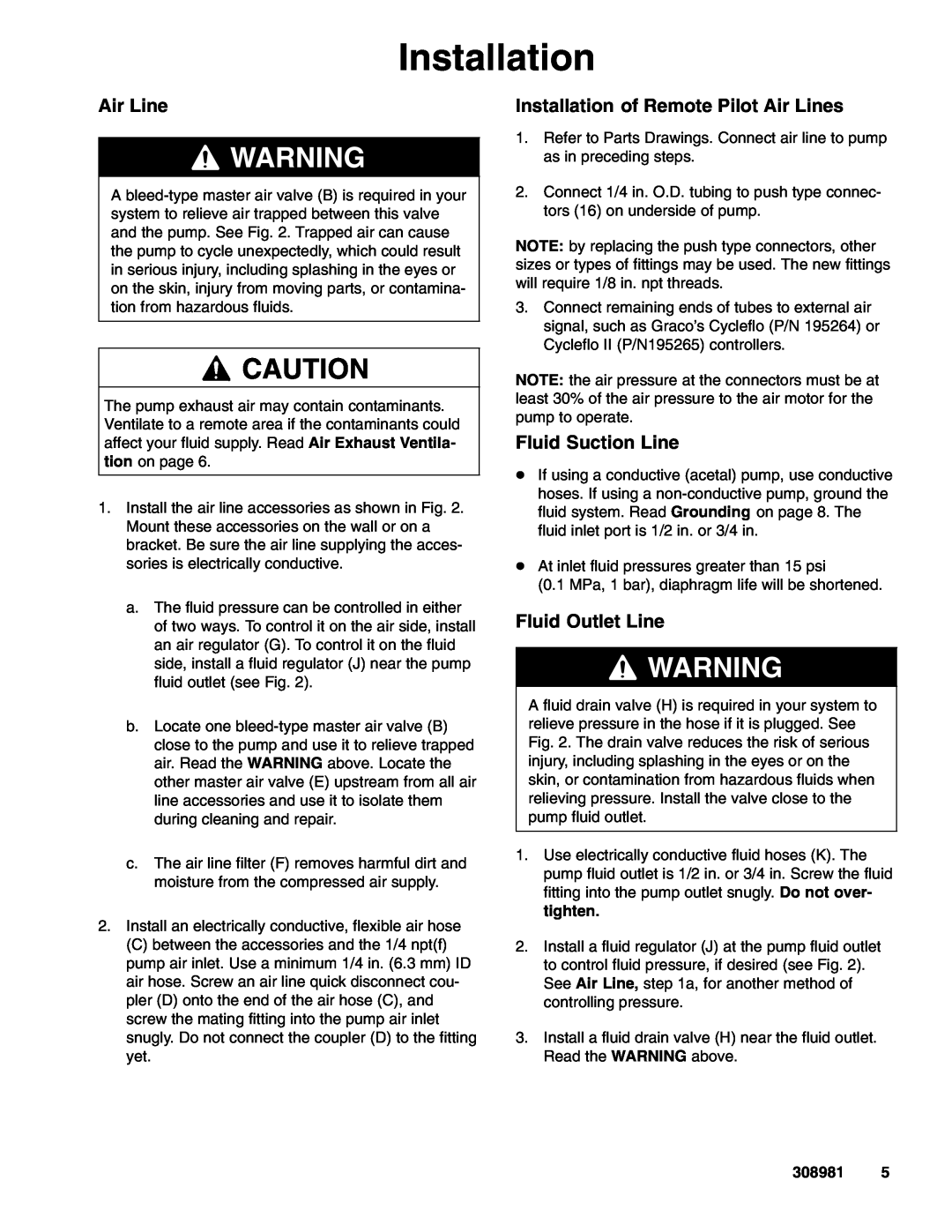
Installation
Air Line
![]() WARNING
WARNING
A
![]() CAUTION
CAUTION
The pump exhaust air may contain contaminants. Ventilate to a remote area if the contaminants could affect your fluid supply. Read Air Exhaust Ventila- tion on page 6.
1.Install the air line accessories as shown in Fig. 2. Mount these accessories on the wall or on a bracket. Be sure the air line supplying the acces- sories is electrically conductive.
a.The fluid pressure can be controlled in either of two ways. To control it on the air side, install an air regulator (G). To control it on the fluid side, install a fluid regulator (J) near the pump fluid outlet (see Fig. 2).
b.Locate one
c.The air line filter (F) removes harmful dirt and moisture from the compressed air supply.
2.Install an electrically conductive, flexible air hose
(C) between the accessories and the 1/4 npt(f) pump air inlet. Use a minimum 1/4 in. (6.3 mm) ID air hose. Screw an air line quick disconnect cou- pler (D) onto the end of the air hose (C), and screw the mating fitting into the pump air inlet snugly. Do not connect the coupler (D) to the fitting yet.
Installation of Remote Pilot Air Lines
1.Refer to Parts Drawings. Connect air line to pump as in preceding steps.
2.Connect 1/4 in. O.D. tubing to push type connec- tors (16) on underside of pump.
NOTE: by replacing the push type connectors, other sizes or types of fittings may be used. The new fittings will require 1/8 in. npt threads.
3.Connect remaining ends of tubes to external air signal, such as Graco’s Cycleflo (P/N 195264) or Cycleflo II (P/N195265) controllers.
NOTE: the air pressure at the connectors must be at least 30% of the air pressure to the air motor for the pump to operate.
Fluid Suction Line
DIf using a conductive (acetal) pump, use conductive hoses. If using a
DAt inlet fluid pressures greater than 15 psi
(0.1 MPa, 1 bar), diaphragm life will be shortened.
Fluid Outlet Line
![]() WARNING
WARNING
A fluid drain valve (H) is required in your system to relieve pressure in the hose if it is plugged. See Fig. 2. The drain valve reduces the risk of serious injury, including splashing in the eyes or on the skin, or contamination from hazardous fluids when relieving pressure. Install the valve close to the pump fluid outlet.
1.Use electrically conductive fluid hoses (K). The pump fluid outlet is 1/2 in. or 3/4 in. Screw the fluid fitting into the pump outlet snugly. Do not over- tighten.
2.Install a fluid regulator (J) at the pump fluid outlet to control fluid pressure, if desired (see Fig. 2). See Air Line, step 1a, for another method of controlling pressure.
3.Install a fluid drain valve (H) near the fluid outlet. Read the WARNING above.
308981 5
